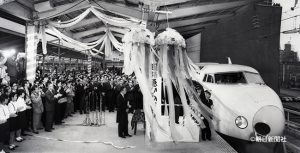Japan has been selected to host the 2020 Olympic and Paralympic Games, with Tokyo, as host city. The 2020 Tokyo Olympics will concentrate mainly within the Kanto region with events also taking place in venues located within parts of the Tohoku, Chubu, and Hokkaido regions. Japan’s extensive railway system (Shinkansen Line, JR Line, and Tokyo Metro) collectively connects the Northernmost regions of Hokkaido to the Southernmost regions of Kyushu and parts of Shikoku. However, Japan has considered the need for further improvements to its railway transportation systems in order to accommodate and serve global visitors, athletes, and local residences simultaneously in the upcoming 2020 Olympics.
The opening and closing ceremonies will take place in the Japan National Stadium or Olympic Stadium, built originally for the 1964 Olympics, in the Southernmost area of the Shinjuku ward, West of the Imperial Palace which is located in the Chiyoda ward. Stations nearest the Olympic Stadium and Tokyo Metropolitan Gymnasium (Sendagaya Station and Shinanomachi Station), will receive upgrades in order to accommodate visitors as well as sustain future activities within one of the largest metropolitan areas in Japan. Moreover, the historic Harajuku Station near Yoyogi National Stadium, built in 1924 and one of the oldest within the Tokyo area, is also set to receive similar upgrades. Another station is planning to be built near Shinagawa Station and Tamachi Station, located West of the Olympic Village. Japanese authorities and organizers also hope to debut the new Maglev bullet train in time for the 2020 Olympic Games and select JR Lines. The Maglev Train, a sure technological milestone in Japanese transportation, is planned to extend from Tokyo to Nagoya (with later extensions into Osaka) and travel at higher speeds than current Shinkansen trains. Its more direct route through mountainous landscapes will allow the Maglev to make the trips from Tokyo to Nagoya in under an hour.
Due to Japan’s extremely dense urban fabric, introducing new innovative spaces and venues to host the Olympic Games becomes a challenge. Nonetheless, Japan has made excellent use of reclaimed land, especially within Tokyo Bay (Zone). Nearly half of the venues are located on reclaimed areas, including the Olympic Village and Broadcasting Centre.
The 2020 Olympic Games are set to take place within two main zones; the ‘Heritage Zone’ and ‘Tokyo Bay Zone’. The National Stadium where the 1964 Olympic Ceremonies took place is planned to undergo a major redesign. Nestled within the ‘Heritage Zone,’ the project illustrates the continued importance of heritage spaces within Japanese landscapes. Japan’s newly created urban spaces, venues, and housing will be located within the ‘Tokyo Bay Zone’. Ultimately, Japan has creating a unique synthesis between old and new in focusing the games around these two major thematic and programmatic zones which will be reinforced via its highly interconnected transport infrastructures. Symbolizing the unbound passion, inspiration, and commitment of elite athletes, and the limitless potentials of future generations, Japan seeks to strengthen its legacy of the 1964 Olympic Games and that of the future 2020 Olympic Games infinitely into tomorrow.

Sources:
https://tokyo2020.jp/jp/games/plan/data/tokyo2020guidebook-1708-EN.pdf
https://www.jrpass.com/map
http://www.jreast.co.jp/press/2016/20160605.pdf
https://www.jrailpass.com/blog/tokyo-2020-olympics
Mock-ups of the new Olympic stadium have been unveiled – it’s going to provide a great stage for the athletes to compete on at #Tokyo2020! pic.twitter.com/2LMwsqhuEj
— #Tokyo2020 (@Tokyo2020) October 17, 2017

